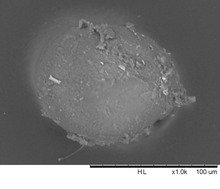User:Lmoy2/sandbox
| Lmoy2/sandbox | |
|---|---|

| |
| Scientific classification | |
| Kingdom: | Fungi
|
| Phylum: | Glomeromycota
|
| Subphylum: | Glomeromycotina
|
| Class: | Glomeromycetes
|
| Order: | Glomerales
|
| Family: | Glomeraceae
|
| Genus: | Funneliformis
|
| Species: | Funneliformis mosseae
|
| Synonyms | |
|
Endogone mosseae (T.H. Nicolson & Gerd., 1968) Glomus mosseae (T.H. Nicolson & Gerd.) Gerd. & Trappe 1974 | |
Funneliformis mosseae[edit]
Funneliformis mosseae (previously referred to as Glomus mosseae: homotypic synonym), Endogone mosseae(basionym) in the family Glomeraceae is an arbuscular mycorrhizal (AM) fungi that forms symbiotic relationships with plant roots. Funneliformis mosseae has a wide distribution worldwide, and can be found in North America, South America, Europe, Africa, Asia and Australia.[1] Funneliformis are characterized by having an easily visible septum in the area of the spore base and are often cylindrical or funnel-shaped. Funneliformis mosseae similarly resembles Gl. caledonium, however the spore wall of Funneliformis mosseae contains three layers, whereas Gl. caledonium spore walls are composed of four layers.[2] Funneliformis is an easily cultivated species which multiplies well in trap culture, along with its high distribution, F. mosseae is not considered endangered and is often used for experimental purposes when combined with another host.[1]
Morphology[edit]
There is some variation in the morphology of these fungi, such as spore color, shape and sporocarp shape.
Spore Structure[edit]
The spores of Funneliformis mosseae are yellow to golden yellow in color and are globose or subglobose (80-)185(-280) µm diameter, with one subtending hypha. The spore wall is made up of three layers all with distinct phenotypes. The first layer is hyaline and mucilogenous and is approximately 1.4-2.5 µm thick (mean = 2.1 µm). This layer is found in the juvenile spores of F. mosseae, and degrades as the spore matures and goes through sloughing, producing a granular appearance. The second layer of the spore wall is also hyaline and is a thickness of 0.8-1.6 µm thick (mean = 1.2 µm). This layer is often observed as sliver-like or partially decomposed fragments as it separates from the third layer of the spore wall. The second layer is variable in appearance between various spores, but must be firmly attached to the laminae as it forms small pits and irregular shape which causes parts of the layer to break away when under pressure. The third layer is a pale yellow to yellow brown, laminate, and is 3.2-6.4 µm thick (mean of 4.7 µm).
Subtending Hyphae[edit]
The Funneliformis mossase species has a subtending hypha, a characteristic of AM fungi, which is the hyphae that the spores are produced from. The hyphae structure tends to be flask shaped and a yellow to yellow brown in color.

Habitat, Distribution, Season[edit]
F. mosseae is a hypogeous fungi, that is commonly found in loose aggregate soils. It has been found in a wide range of locations, and can be collected throughout the year, in all seasons. It is widespread in the Pacific Northwest, Midwest, Hawaii, England, Scotland, Germany, Australia, New Zealand and Pakistan. F. mosseae can withstand conditions ranging from coastal dune sands, mountain forests, and semi-arid zones; especially in alkaline flats, roadbanks, fields and forest clearings.
Arbuscular Mycorrhizal Interactions[edit]

F. mosseae is a fungi that falls into the category of arbuscular mycorrhizal fungi (AMF), which are fungi that form symbiotic relationships with most terrestrial plants. The relationship is mutualistic, meaning that both the plant and fungi have benefits in forming these interactions with one another. Arbuscules are the site of entrance into the plant cells for the fungi, and a large hyphal network is formed, which allows for nutrient exchanges between the plant and fungi. Plants can often benefit greatly from these mutualistic interactions with certain fungi, such as increased nutrient absorption, resistance to varying environmental conditions, and resistance to some plant pathogens. Because F. mosseae is an easily cultivated fungi in vitro, it has been used many times to observe how these AMF interactions work.[3]
Funneliformis mosseae and Anethum graveolens[edit]
This study observed the interactions between Funneliformis mosseae and Anethum graveolens, otherwise known as the essential oils produced from dill. The purpose of this study was to discover if the inoculation of F. mosseae in the roots of Anethum graveolens would increase the production of essential oil, which contain antimicrobials that protect against plant pathogens,, significantly different from a plant that was not inoculated with F. mosseae. The plant pathogen used in this experiment to test the efficacy of the produced essential oils was Colletotrichum nymphaeae, which is the infectious agent for strawberry anthracnose. The constituents of both the inoculated and uninoculated experimental samples had similar compositions as shown through a gas chromatography mass-spectrometry analysis. However, the inoculated essential oil products contained higher concentrations of limonene and carvone, which are known antimicrobial compounds.[4]
Funneliformis mosseae and Robinia pseudoacacia L. (Increased resistance to heavy metal toxicity)[edit]
For the means of this study, samples of Robinia pseudoacacia L. were inoculated with Funneliformis mosseae and some without. These seedlings were planted in soils with varying levels of lead (Pb) contamination. The results of this study showed that
DNA Sequence[edit]
GACCTCAAATCAGGTAAGAATACCCGCTGAACTTAAGCATATCAATAAGCGGAGGAAAAGAAAATAACAATGATTCCCTCAGTAACGGCGAGCGAAGAGGGATAAGCTCAAATTTTAAATCTGTTGGGTTCCACTTAACAGAGTTGTATTTTGAAGAAACGTTTTCTGCATCCAGGATTAGCCTAAATCCTTTGGGATAAGGTATCATGGAGGGTGAGAATCCCGTTCATGGTTAATCTTAAGGAAGCTCTACGATACGTTTTCCAAGAGTCGAGTTGTTTGGGATTGCAGCTCAAAATGGGAGGTAAATTTCTCCTAAGGCTAAATATTGGCGAGAGACCGATAGCGAACAAGTACCGTGAGGGAAAGATGAAAAGAACTTTGAAAAGAGAGTTAAACAGTACGTGAAATTGTTGAAAGGGAAACGATTGAAGTCAGTCATACCAACGGGAAATCAACCTTTTGAGTTCGGTCTCGTGGGTTTTGAAGAGTTTCAAAGCCTTCGGATTCGCGGGATTGGGATCTCTTGGTGTACTTTTTCGTACGGTTAGTCAACATCGGTTTTGAATGTCATAAAATGACTGGAGGAATGTAGCTTCGATCTCGTATTGAAGTGTTATAGCCTTTGGTAGATGTGATGTTTGAGACCGAGGATTGCAACGGATACCCTTCAGGGCTATTCGTCTGATCTCTGATACGTTGCCTTGATGTTGAAAGCTTGCTTATGATGTTAGGGTATTACGGTCAAAAGGTTAGAACGGATTAGATTCGTTAAGGATGTTGACGTAATGACTTTAAACGACCCGTCTTGAAACACGGACCAAGGAGTCTAACATATATGCGAGTGTTTGGGTGATTAAACCCTTGCGCGTAATGAAAGTAATTTTGGTGAGATCCGGGAAAAAATTTTCGGAGCATCATCGACCGATCAGGATATTT
References[edit]
- ^ a b "Funneliformis mosseae". iucn.ekoo.se. Retrieved 2022-04-11.
- ^ "Glomus mosseae". www.zor.zut.edu.pl. Retrieved 2022-04-11.
- ^ "Arbuscular mycorrhizal fungi: tiny friends with big impact | Turfgrass Science". turf.umn.edu. Retrieved 2022-04-19.
- ^ Karimi, Kaivan; Ahari, Asadollah Babai; Weisany, Weria; Pertot, Ilaria; Vrhovsek, Urska; Arzanlou, Mahdi (2016-11-15). "Funneliformis mosseae root colonization affects Anethum graveolens essential oil composition and its efficacy against Colletotrichum nymphaeae". Industrial Crops and Products. 90: 126–134. doi:10.1016/j.indcrop.2016.06.024. ISSN 0926-6690.
